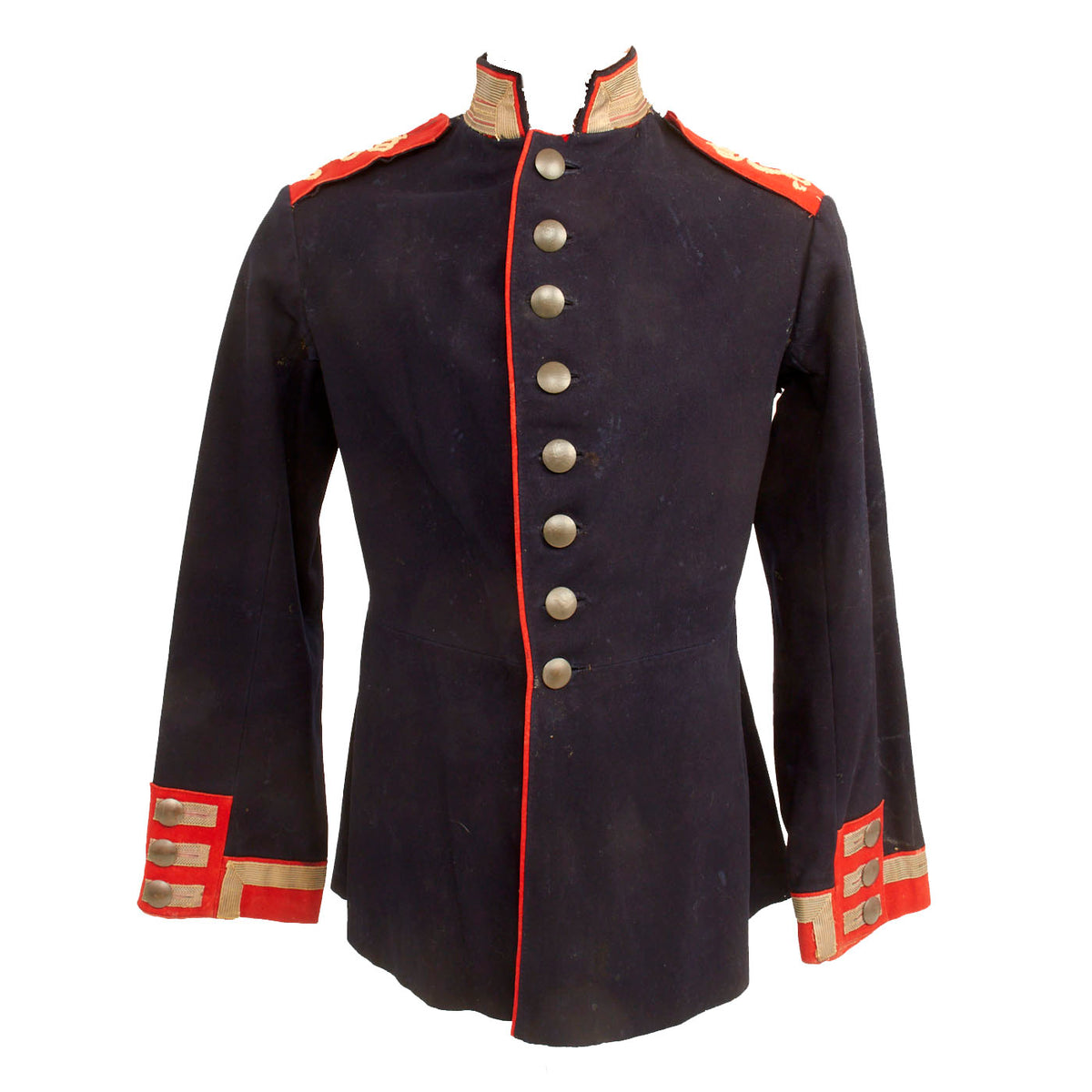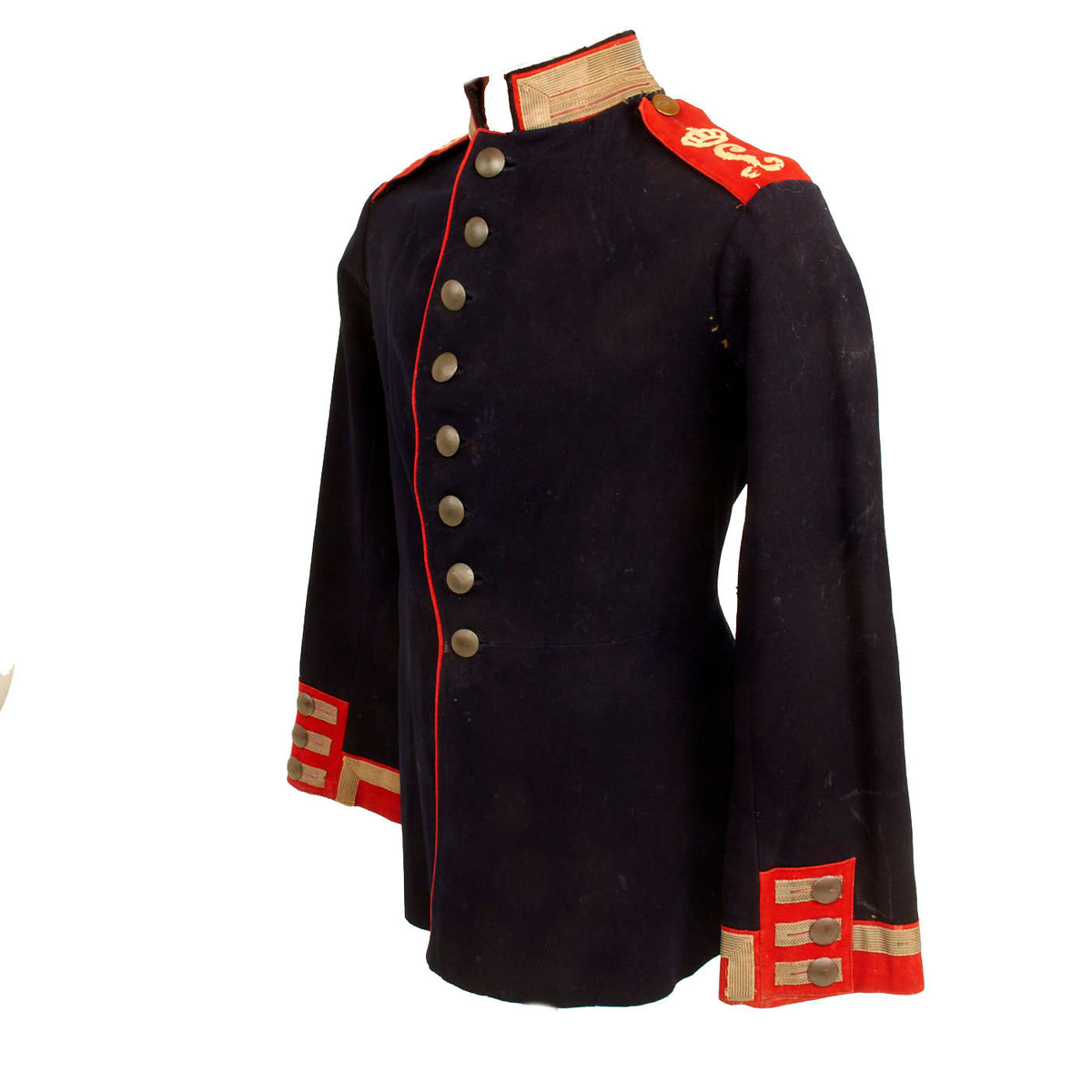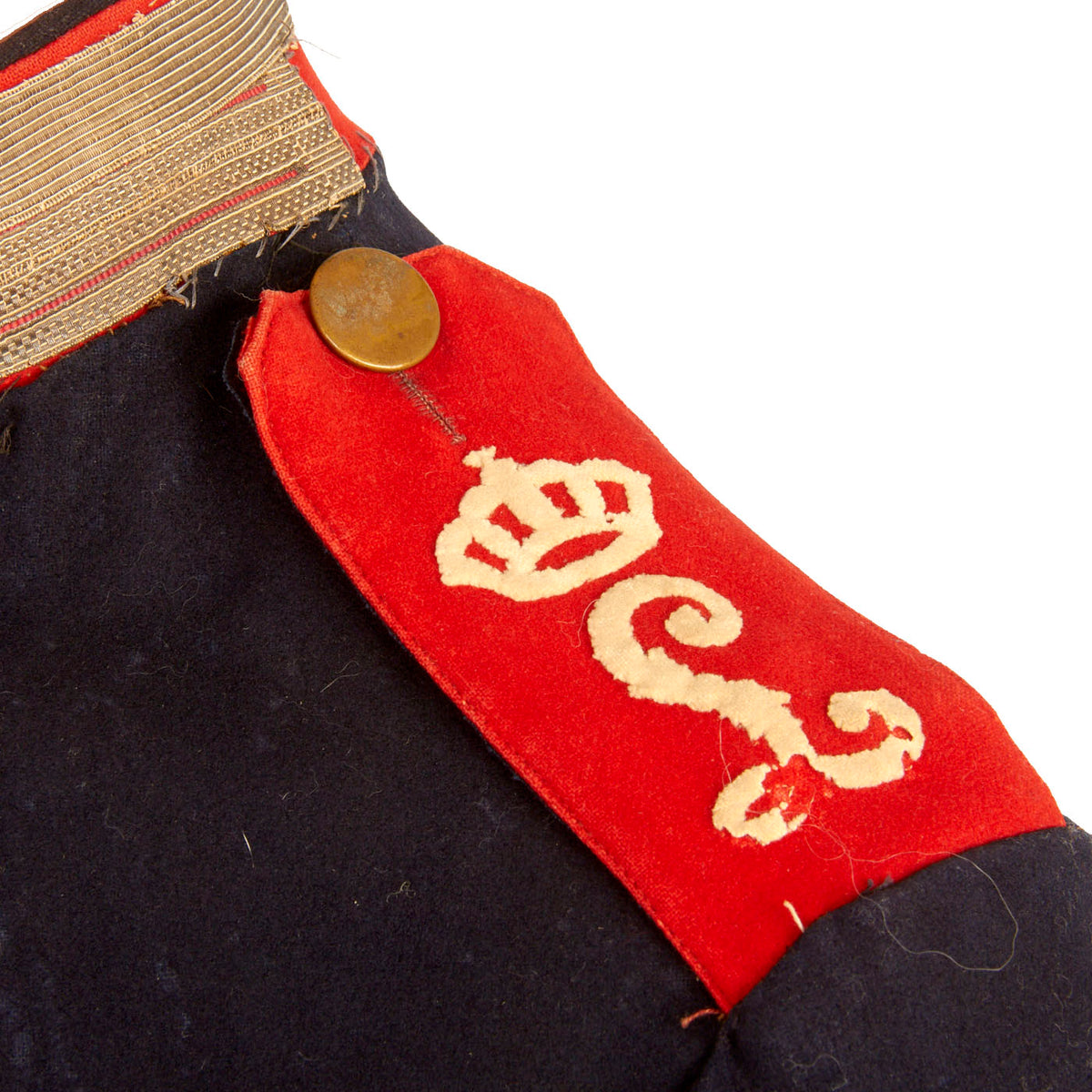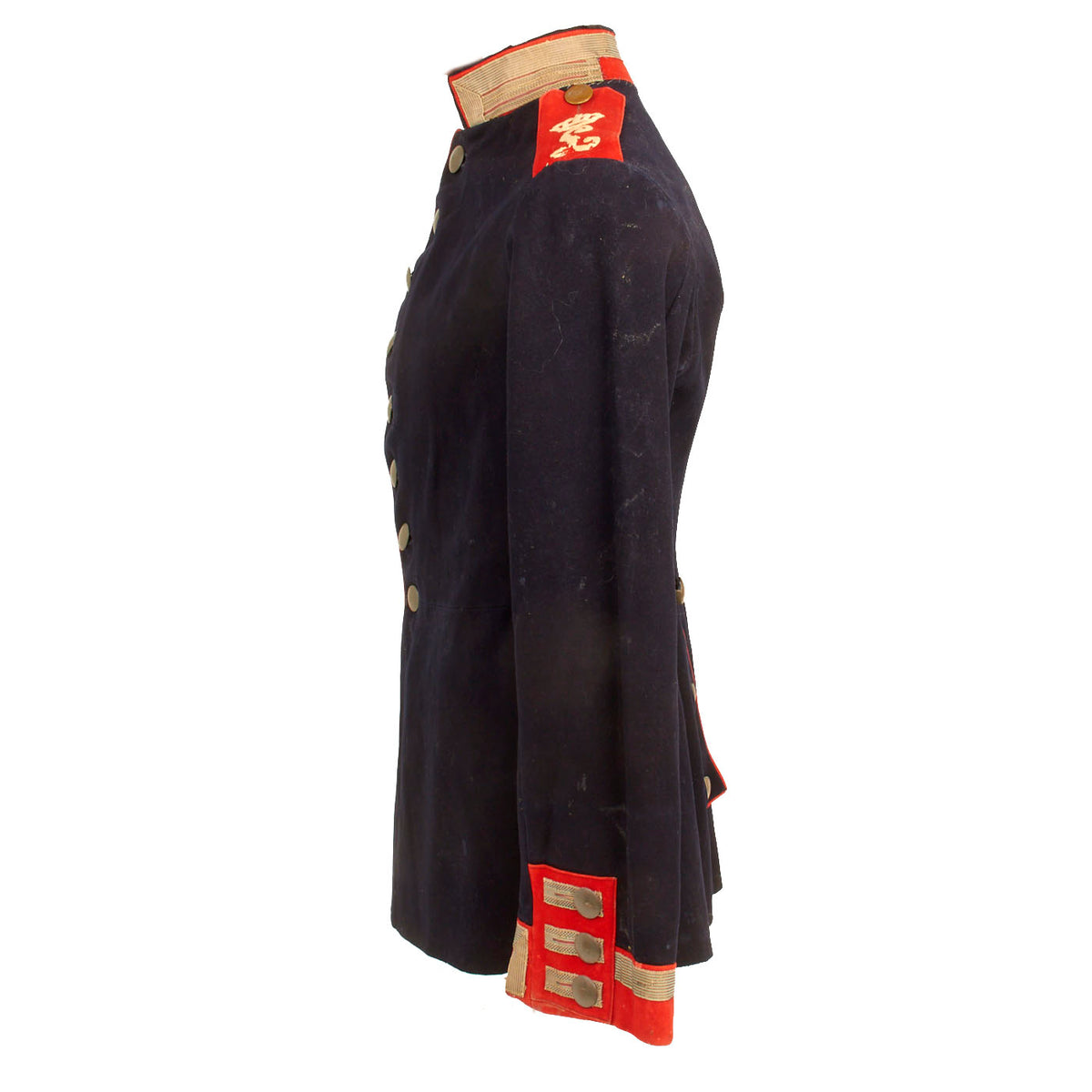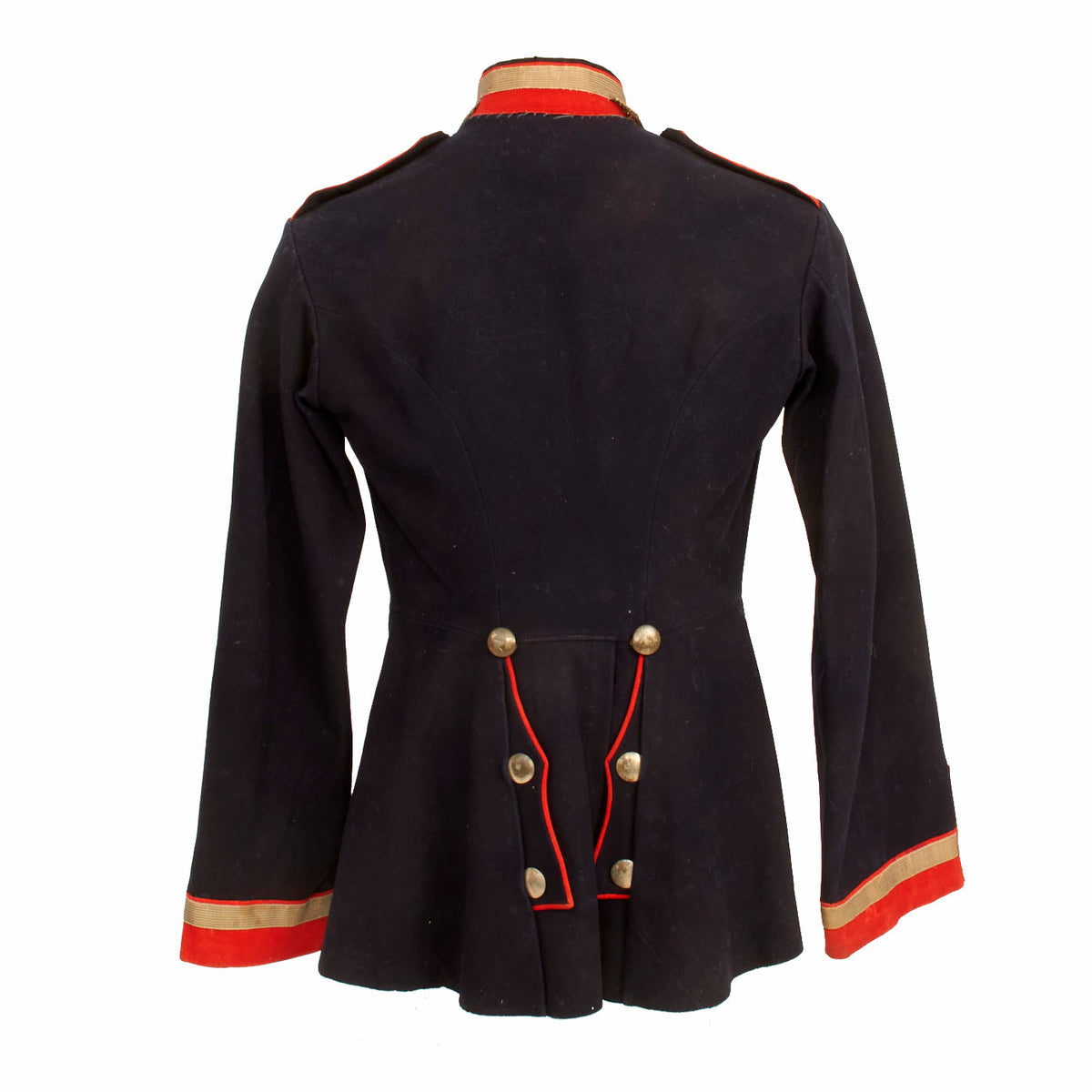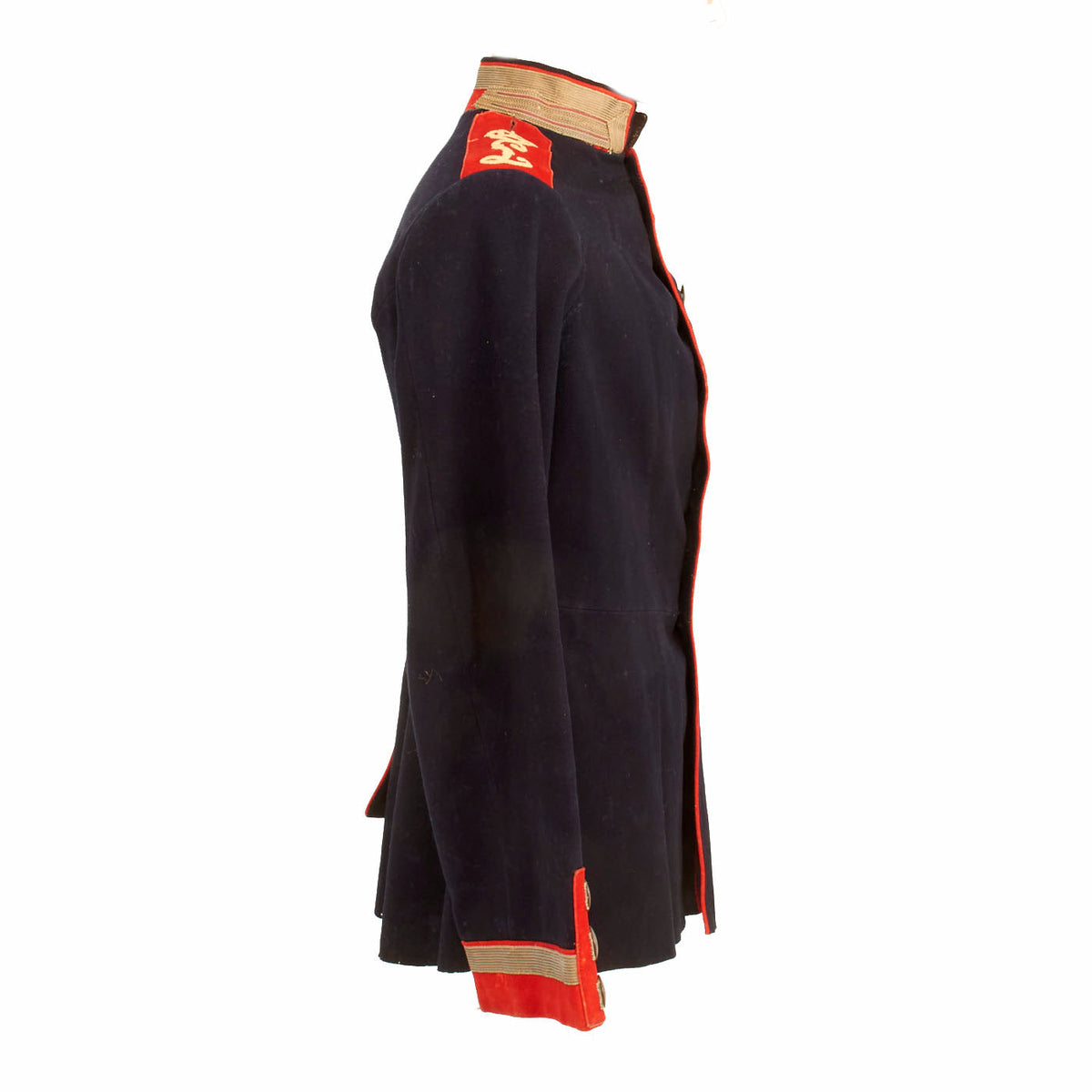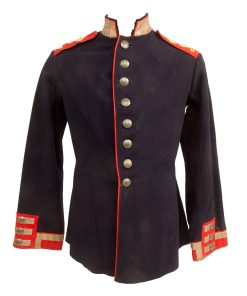Original German Pre-WWI Model 1895 Prussian Leibgarde Infanterie Regiment Waffenrock With Brandenburg Cuffs Original Items
$ 995,00 $ 248,75
Original Item: Only One Available. This is a lovely M-1895 Prussian Waffenrock, featuring the beautiful Brandenburg Cuffs! In 1842, Preußen (Prussia) introduced a new pattern of uniform for all foot-troops consisting of a uniform called a Waffenrock to be worn with a tall leather spiked helmet called a Pickelhaube. This form of dress was considerably different from the short Kollet (a waist-length jacket with tails) worn with the high leather Tschako during the Napoleonic wars.
Dunkelblau (dark blue) Waffenrock were typically worn by Infantry, Feldartillerie (Field Artillery), Fußartillerie (Foot Artillery) Regiments, Train (Supply), Pionier (Pioneers) and most other units. Hellblau (light blue) Waffenrock were worn by the majority of Dragoner (Mounted Infantry) Regiments (except Hessen) while dark green Waffenrock were worn by Jäger (light Infantry) Battalions.
Issued Waffenrocks tend to be dark while Eigetumsstück (privately purchased) Waffenrocks are much lighter in color. Officer’s Waffenrock, when compared to an issued Waffenrock from the same unit, are considerably lighter in color as they were privately purchased. Conjointly, the lighter color was probably deemed “more fashionable” than the darker issued Waffenrocks of the men.
An AKO on 25 April 1895 announced the final refinements to the Waffenrock. The collar height on issue Waffenrock ranged from 4.5 to 5 cm, however, privately purchased Waffenrock invariably have higher collars ranging from 6 cm to 7 cm. Buttons were reduced in size from 25mm to 21mm. The rear skirt was given an actual vent on the M1895 Waffenrock, allowing the two rear skirt liner pockets to be accessed through a long vertical slit opening between the rear scallops. The color of the Waffenrock ranged from light to dark blue or green and the collar and cuffs came in a rainbow of colors as did the shoulder straps. The Waffenrock was to stay in this form until the eventual replacement by the M1907/10 Feldgrau Feldrock.
This M1895 has a lovely 2” (5cm) standing collar, which is an indication of this being an issued one and not a private purchase. The color is the correct Dunkelblau and has red Brandenburg Cuffs. The Brandenburg cuff has a horizontal panel (usually red) around the circumference of the cuff, with a vertical panel superimposed on top. The vertical panel has three buttons. Both horizontal and vertical panels are often piped in the Army Corps color.
The shoulder straps bear the cipher for the Leibgarde Infanterie Regiment which is an L beneath a crown. There is some mothing present on the straps and the top button on the right shoulder is missing.
The overall condition is nice but there are some factors that affect the condition. The piping on the collar is missing from the back with deteriorated stitching. There is also minor separation in the collar as well. All buttons are present and there is some deterioration to the inner lining, as well as staining, an indication of this uniform being worn.
This is still a lovely example and not too many are left on the market! Comes ready to display!
Measurements:
Collar to shoulder: 9”
Shoulder to sleeve: 23”
Shoulder to shoulder: 17”
Chest width: 16”
Waist width: 15.5”
Hip width: 20”
Front length: 29.5″
Leibgarde Infanterie Regiment
The Life Guards Infantry Regiment (1st Grand-Ducal Hessian) No. 115 was a unit of the Grand- Ducal Hessian Army , which had been integrated as a contingent into the Prussian Army since the military convention with Prussia in 1867 , and there most recently the Grand- Ducal Hessian (25th) Division formed.
Uniforming
Blue tunic according to the Prussian pattern with red insignia. Gardelitzen made of white wool (silver for officers) were worn on the collar and on the Brandenburg lapels . As a special feature, the officers’ lower sleeve braids were not buttoned through, and the background of the buttonholes was lined in white instead of the usual lapel color (here red). A crowned “L” and from 1909 [2] just such an “EL” were worn on the shoulder pieces. The 1st company was called “Leibkompanie” and had an “L” on the buttons of the epaulettes instead of the usual company number. The new model of the spiked helmet from 1887 had all fittings in white metal, on the front the armored and crowned Hessian lion surrounded by branches, in the background a bandeau with the years “1621” and “1897”, plus the star of the guard on top. This was in enamel and raised for the officers. The buckle wore only a 5-bar crown in white metal. The officer’s sash was made of silver and had three red threads. The sash in the same color scheme, the lock was provided with a crowned “EL”. The officers’ epaulettes were silver with red penetration. In 1913 the field gray uniform was worn for the first time during maneuvers and exercises.
In 1908 and 1909 the Leibkompanie won the Kaiserpreis for best shooting performance within the XVIII. Army Corps and was allowed to wear a corresponding badge on the coat sleeve.
Fast Shipping with Professional Packaging
Thanks to our longstanding association with UPS FedEx DHL, and other major international carriers, we are able to provide a range of shipping options. Our warehouse staff is expertly trained and will wrap your products according to our exact and precise specifications. Prior to shipping, your goods will be thoroughly examined and securely secured. We ship to thousands clients each day across multiple countries. This shows how we're dedicated to be the largest retailer on the internet. Warehouses and distribution centres can be located throughout Europe as well as the USA.
Note: Orders with more than one item will be assigned a processing date depending on the item.
Before shipping before shipping, we'll conduct a thorough inspection of the items you have ordered. Today, the majority of orders will be delivered within 48 hours. The delivery time will be between 3-7 days.
Returns
The stock is dynamic and we cannot completely manage it because multiple stakeholders are involved, including our factory and warehouse. So the actual stock may alter at any time. It's possible that you may not receive your order once the order has been made.
Our policy is valid for a period of 30 days. If you don't receive the product within 30 days, we are not able to issue a refund or an exchange.
You can only return an item if it is unused and in the same state as the day you received it. You must have the item in its original packaging.
Related products
Uncategorized
Uncategorized
Uncategorized
Uncategorized
Uncategorized
Uncategorized
Angolan Rebel 1970s era 60mm Inert Display Mortar from Angolan Civil War Original Items
Uncategorized
Armoured Fighting Vehicles of the World: AFVs of World War One (Hardcover Book) New Made Items
Uncategorized
Uncategorized
Uncategorized
Uncategorized
Uncategorized
Uncategorized
Uncategorized
Armored Burgonet Helmet & Polearm from Scottish Castle Leith Hall Circa 1700 Original Items
Uncategorized
Uncategorized
Uncategorized
Uncategorized
Australian WWII Owen MK1 Machine Carbine SMG Custom Fabricated Replica with Sling Original Items
Uncategorized
Uncategorized
Uncategorized
